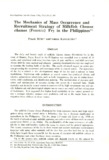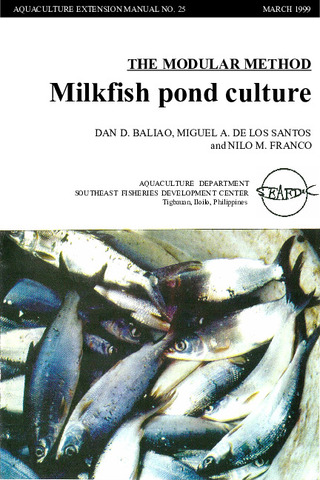The mechanics of mass occurrence and recruitment strategy of milkfish Chanos chanos (Forsskal) fry in the Philippines
- Global styles
- MLA
- Vancouver
- Elsevier - Harvard
- APA
- Help

閲覧/開く
日付
1983Page views
2,259ASFA keyword
AGROVOC keyword
Taxonomic term
Metadata
アイテムの詳細レコードを表示する
Share
抄録
The daily and hourly catch of milkfish Chanos chanos (Forsskal) fry in the coast of Hamtic, Panay Island in the Philippines was recorded over a period of 16 weeks, and correlated with time, location, types of gear, and lunar and tidal variations. About 4000 fry were marked and released, scanning electronmicroscopy was employed to examine the feeding habit of the fish. The results obtained suggest an active process governing the occurrence and movement of fry in coastal waters. The appearance of the fry is related to the developmental stage of the fry and is subject to lunar modulation. Interaction with predators in coastal waters has produced diverse and selective antipredator adaptations, such as body transparency, the use of timing (seasonality, tidal conditions), and distribution patterns. The maximization of resource utilization and minimization of resource sharing also occurs in a seasonal basis. High mortality rate in shallow coastal waters is counteracted by high recruitment rate and specific behavioural and physiological adaptations to ensure successful and fast colonization of backwaters. It is suggested that higher food availability in the nursery ground exerts a stronger selective pressure over predation, and act as the major force in the migration from offshore to shore waters.
記述
Contribution No. 107 of the Aquaculture Department, SEAFDEC.
Suggested Citation
Buri, P., & Kawamura, G. (1983). The mechanics of mass occurrence and recruitment strategy of milkfish Chanos chanos (Forsskal) fry in the Philippines. Memoirs of the Kagoshima University Research Center for the South Pacific , 3(2), 33-55. http://hdl.handle.net/10862/1133
Type
ArticleISSN
0389-5351Collections
- Journal Articles [1256]
Related items
Showing items related by title, author, creator and subject.
-
Series: Aquaculture extension manual; No. 25
The modular method: Milkfish pond culture
Baliao, Dan D.; de los Santos, Miguel A.; Franco, Nilo M. (Aquaculture Department, Southeast Asian Fisheries Development Center, 1999)The modular method of milkfish culture (Chanos chanos) described in the manual is an improvement over the traditional extensive method. The manual is intended for the use of fish farmers and aquaculturists, extensionists, ... -
Evaluation of organic and inorganic fertilizers in brackishwater milkfish ponds
Bombeo-Tuburan, Isidra; Agbayani, Renato F.; Subosa, Precilla F. (Elsevier, 1989)The study was conducted in twelve 144-m2 ponds to evaluate the effect of different organic and inorganic fertilizers on the growth, survival, gross production, and profitability of marketable milkfish. The ... -
Milkfish breeding and hatchery technology at SEAFDEC/AQD
著者不明 (Aquaculture Department, Southeast Asian Fisheries Development Center, 1999)Describes the techniques already adopted by the private sector: broodstock management, broodstock diet, commercial fry production, live transport, and larval diet. A list of AQD research publications on milkfish is included.





